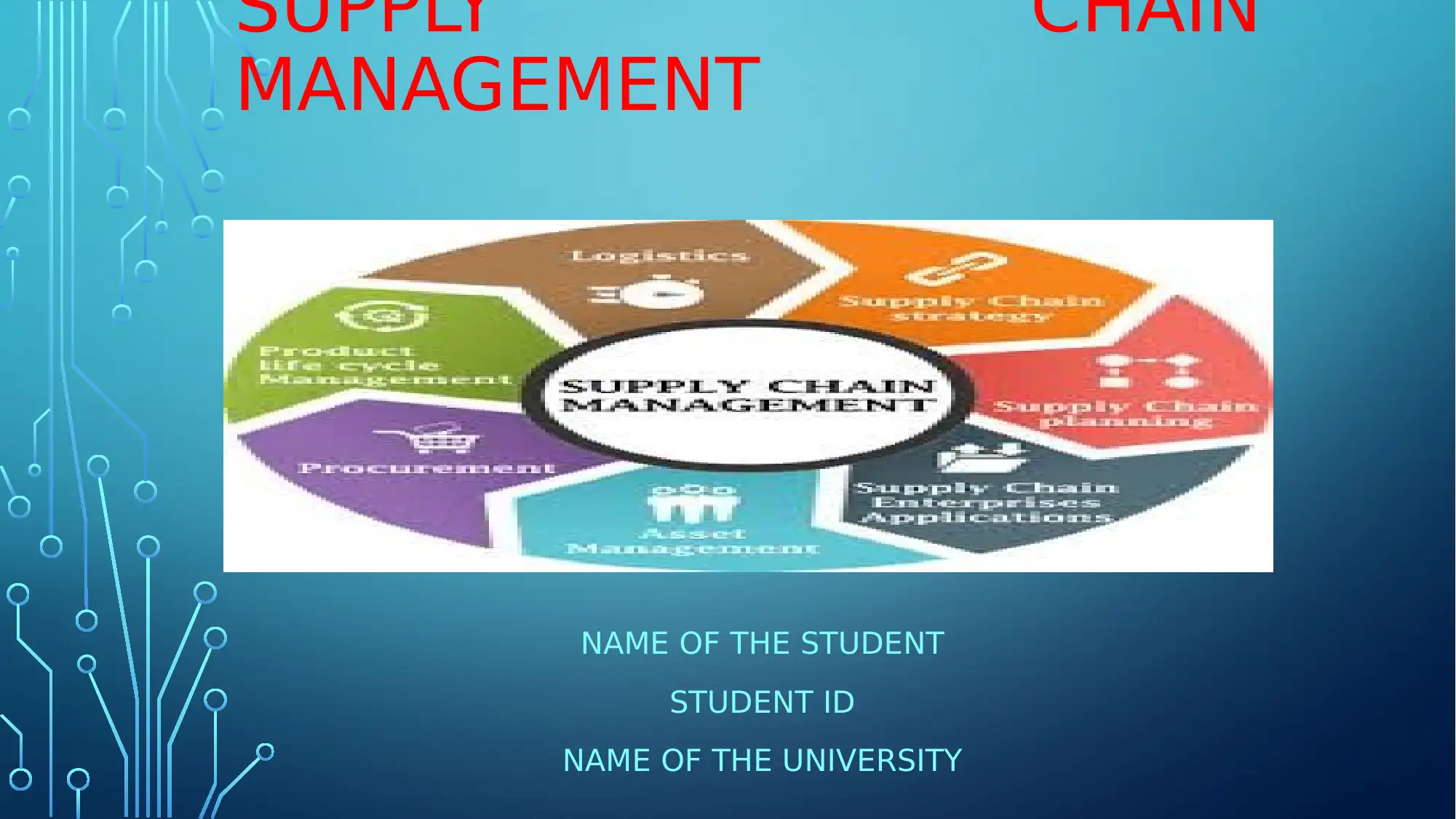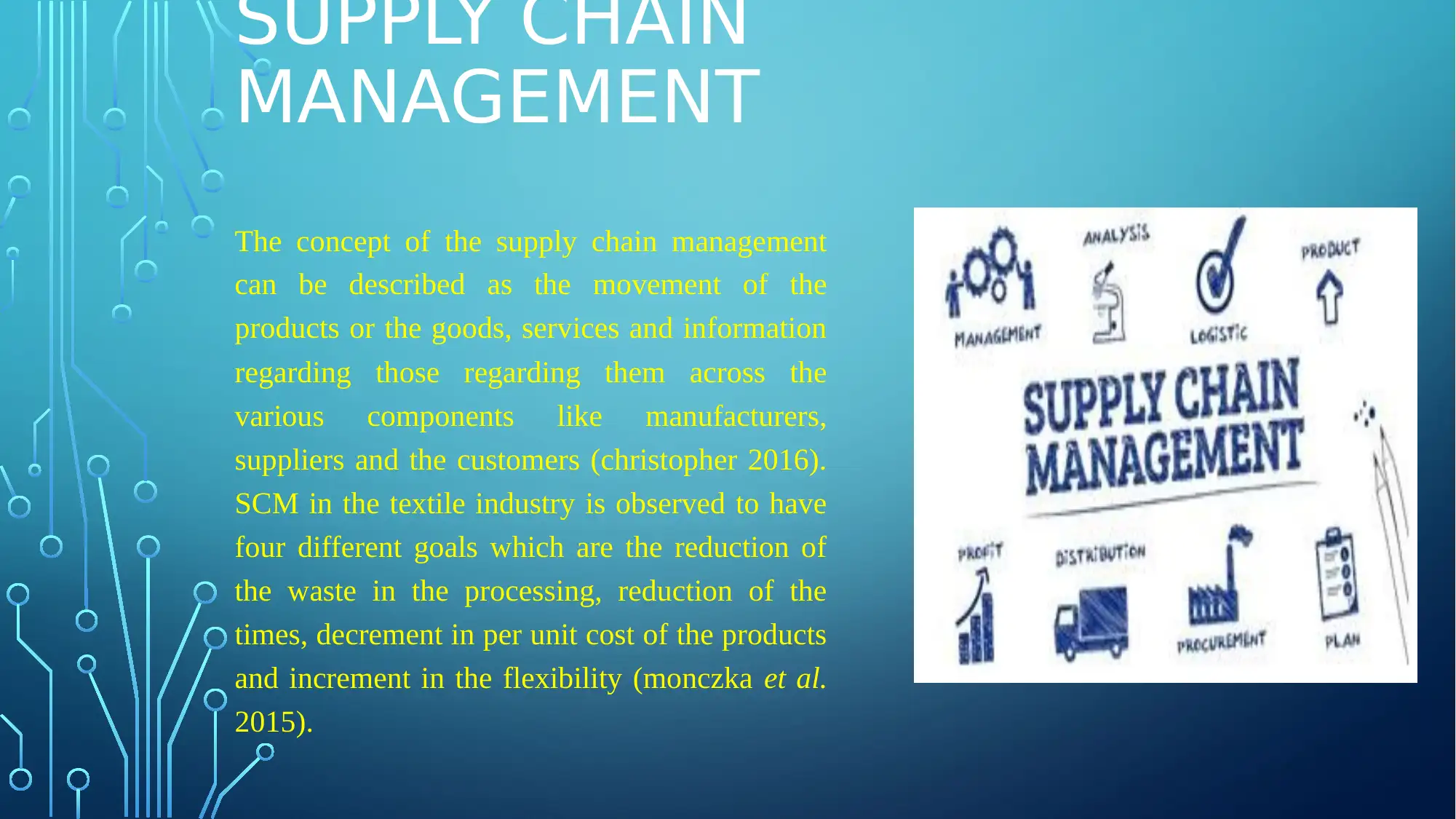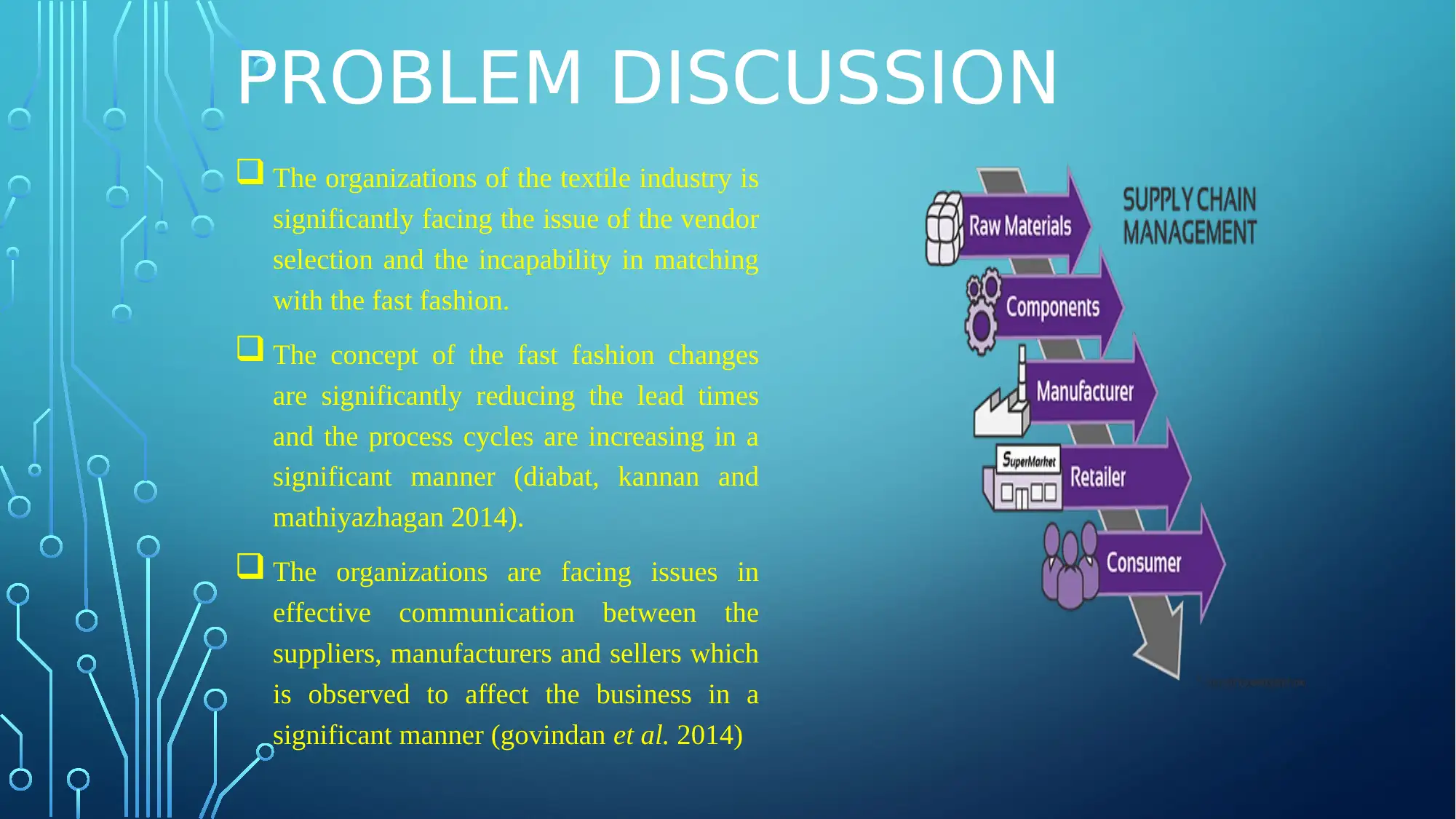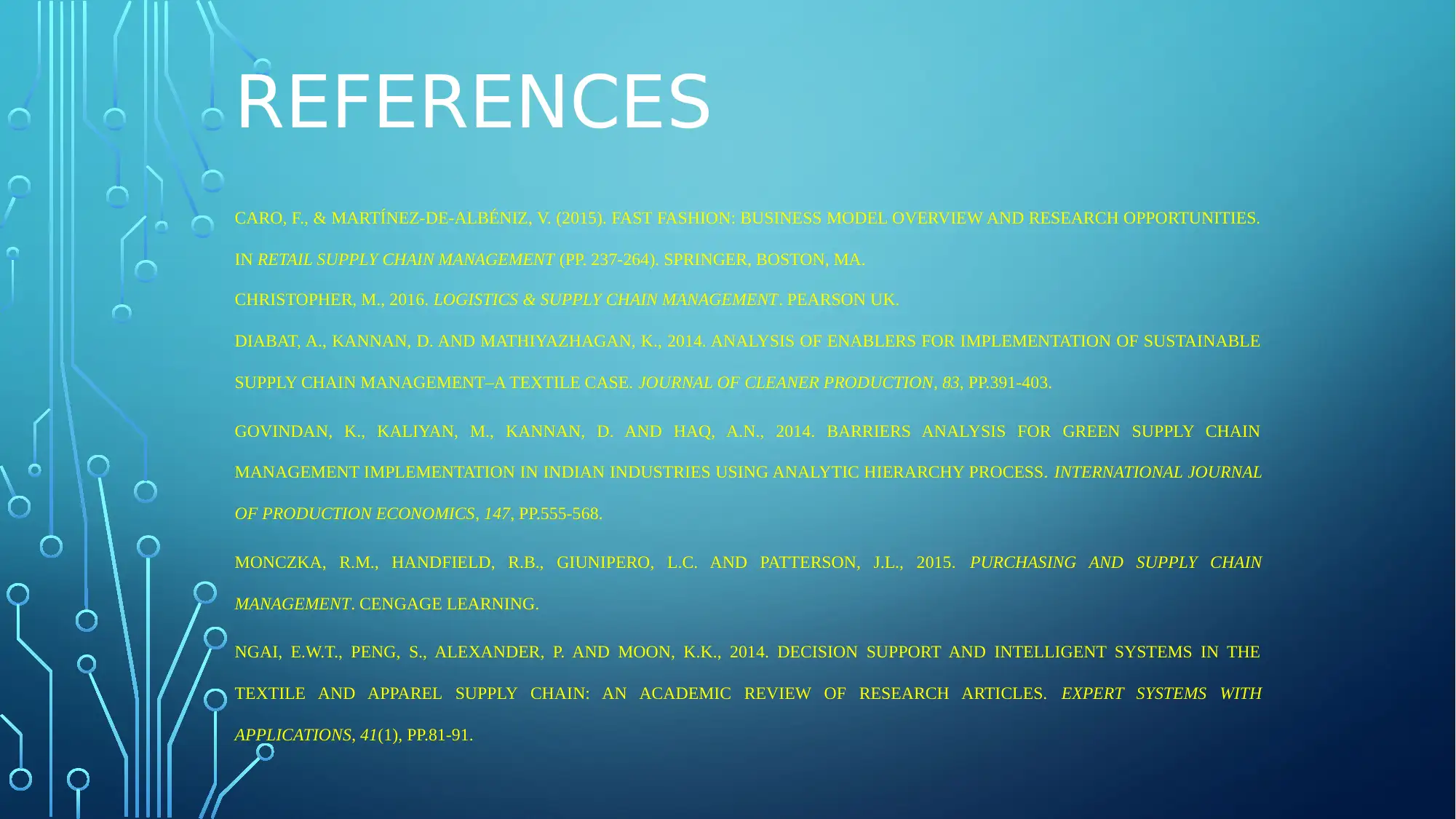Supply Chain Management: Addressing Challenges in Textile Sector
VerifiedAdded on 2023/06/03
|7
|748
|238
Report
AI Summary
This report delves into the complexities of supply chain management within the textile industry, highlighting key challenges such as vendor selection difficulties, adapting to fast fashion trends, and communication gaps between suppliers, manufacturers, and sellers. The report proposes solutions...

SUPPLY CHAIN
MANAGEMENT
NAME OF THE STUDENT
STUDENT ID
NAME OF THE UNIVERSITY
MANAGEMENT
NAME OF THE STUDENT
STUDENT ID
NAME OF THE UNIVERSITY
Paraphrase This Document
Need a fresh take? Get an instant paraphrase of this document with our AI Paraphraser

SUPPLY CHAIN
MANAGEMENT
The concept of the supply chain management
can be described as the movement of the
products or the goods, services and information
regarding those regarding them across the
various components like manufacturers,
suppliers and the customers (christopher 2016).
SCM in the textile industry is observed to have
four different goals which are the reduction of
the waste in the processing, reduction of the
times, decrement in per unit cost of the products
and increment in the flexibility (monczka et al.
2015).
MANAGEMENT
The concept of the supply chain management
can be described as the movement of the
products or the goods, services and information
regarding those regarding them across the
various components like manufacturers,
suppliers and the customers (christopher 2016).
SCM in the textile industry is observed to have
four different goals which are the reduction of
the waste in the processing, reduction of the
times, decrement in per unit cost of the products
and increment in the flexibility (monczka et al.
2015).

PROBLEM DISCUSSION
The organizations of the textile industry is
significantly facing the issue of the vendor
selection and the incapability in matching
with the fast fashion.
The concept of the fast fashion changes
are significantly reducing the lead times
and the process cycles are increasing in a
significant manner (diabat, kannan and
mathiyazhagan 2014).
The organizations are facing issues in
effective communication between the
suppliers, manufacturers and sellers which
is observed to affect the business in a
significant manner (govindan et al. 2014)
The organizations of the textile industry is
significantly facing the issue of the vendor
selection and the incapability in matching
with the fast fashion.
The concept of the fast fashion changes
are significantly reducing the lead times
and the process cycles are increasing in a
significant manner (diabat, kannan and
mathiyazhagan 2014).
The organizations are facing issues in
effective communication between the
suppliers, manufacturers and sellers which
is observed to affect the business in a
significant manner (govindan et al. 2014)
⊘ This is a preview!⊘
Do you want full access?
Subscribe today to unlock all pages.

Trusted by 1+ million students worldwide

TOOLS AS SOLUTION (AHP)
THE AHP WILL ANSWER THE PROBLEM OF THE SUPPLIERS’
SELECTION BY A FIVE STEP METHOD.
At first a specification regarding the sets of criteria is to be made for
the proper evaluation of the suppliers’ proposal (caro & martínez-de-
albéniz 2015).
In the next step the achievement of a pairwise comparison on the
relative importance of the criteria regarding the achievement of the
objectives is to be executed along with the evaluation of the priorities
of the criteria depending on this information (ngai et al. 2014).
The third step will observe the measurement of each supplier’s
achievement of the criteria.
This information will be used in the step 4 in order to
achieve the pairwise comparisons of the relative
importance of the suppliers depending on the criteria in
order to calculate the respective priorities.
At the last step the results of the step 2 and 4 will be used to calculate
the priorities of every supplier in obtaining the goal of hierarchy
THE AHP WILL ANSWER THE PROBLEM OF THE SUPPLIERS’
SELECTION BY A FIVE STEP METHOD.
At first a specification regarding the sets of criteria is to be made for
the proper evaluation of the suppliers’ proposal (caro & martínez-de-
albéniz 2015).
In the next step the achievement of a pairwise comparison on the
relative importance of the criteria regarding the achievement of the
objectives is to be executed along with the evaluation of the priorities
of the criteria depending on this information (ngai et al. 2014).
The third step will observe the measurement of each supplier’s
achievement of the criteria.
This information will be used in the step 4 in order to
achieve the pairwise comparisons of the relative
importance of the suppliers depending on the criteria in
order to calculate the respective priorities.
At the last step the results of the step 2 and 4 will be used to calculate
the priorities of every supplier in obtaining the goal of hierarchy
Paraphrase This Document
Need a fresh take? Get an instant paraphrase of this document with our AI Paraphraser

TOOLS AS SOLUTION
The information regarding the movement of the
products will be achieved by scanning the stored
information of the products which are sold and
moving out from the stocks.
The information of the products are to be stored in
the radio frequency identification scanners or RFID
tags and for the scanning, each outlets of the
organizations must have the point-of sales scanner.
The scanned information from the RFID tags will be
transmitted to each and every department of the
supply chain management by means of the
enterprise resource planning or ERP with the help of
the internet.
Following this format, the manufacturers and the
suppliers will be able to monitor the requirements on
their own and it will also enable them to have the
insights regarding the required quality and quantity
of the materials.
The information regarding the movement of the
products will be achieved by scanning the stored
information of the products which are sold and
moving out from the stocks.
The information of the products are to be stored in
the radio frequency identification scanners or RFID
tags and for the scanning, each outlets of the
organizations must have the point-of sales scanner.
The scanned information from the RFID tags will be
transmitted to each and every department of the
supply chain management by means of the
enterprise resource planning or ERP with the help of
the internet.
Following this format, the manufacturers and the
suppliers will be able to monitor the requirements on
their own and it will also enable them to have the
insights regarding the required quality and quantity
of the materials.

REFERENCES
CARO, F., & MARTÍNEZ-DE-ALBÉNIZ, V. (2015). FAST FASHION: BUSINESS MODEL OVERVIEW AND RESEARCH OPPORTUNITIES.
IN RETAIL SUPPLY CHAIN MANAGEMENT (PP. 237-264). SPRINGER, BOSTON, MA.
CHRISTOPHER, M., 2016. LOGISTICS & SUPPLY CHAIN MANAGEMENT. PEARSON UK.
DIABAT, A., KANNAN, D. AND MATHIYAZHAGAN, K., 2014. ANALYSIS OF ENABLERS FOR IMPLEMENTATION OF SUSTAINABLE
SUPPLY CHAIN MANAGEMENT–A TEXTILE CASE. JOURNAL OF CLEANER PRODUCTION, 83, PP.391-403.
GOVINDAN, K., KALIYAN, M., KANNAN, D. AND HAQ, A.N., 2014. BARRIERS ANALYSIS FOR GREEN SUPPLY CHAIN
MANAGEMENT IMPLEMENTATION IN INDIAN INDUSTRIES USING ANALYTIC HIERARCHY PROCESS. INTERNATIONAL JOURNAL
OF PRODUCTION ECONOMICS, 147, PP.555-568.
MONCZKA, R.M., HANDFIELD, R.B., GIUNIPERO, L.C. AND PATTERSON, J.L., 2015. PURCHASING AND SUPPLY CHAIN
MANAGEMENT. CENGAGE LEARNING.
NGAI, E.W.T., PENG, S., ALEXANDER, P. AND MOON, K.K., 2014. DECISION SUPPORT AND INTELLIGENT SYSTEMS IN THE
TEXTILE AND APPAREL SUPPLY CHAIN: AN ACADEMIC REVIEW OF RESEARCH ARTICLES. EXPERT SYSTEMS WITH
APPLICATIONS, 41(1), PP.81-91.
CARO, F., & MARTÍNEZ-DE-ALBÉNIZ, V. (2015). FAST FASHION: BUSINESS MODEL OVERVIEW AND RESEARCH OPPORTUNITIES.
IN RETAIL SUPPLY CHAIN MANAGEMENT (PP. 237-264). SPRINGER, BOSTON, MA.
CHRISTOPHER, M., 2016. LOGISTICS & SUPPLY CHAIN MANAGEMENT. PEARSON UK.
DIABAT, A., KANNAN, D. AND MATHIYAZHAGAN, K., 2014. ANALYSIS OF ENABLERS FOR IMPLEMENTATION OF SUSTAINABLE
SUPPLY CHAIN MANAGEMENT–A TEXTILE CASE. JOURNAL OF CLEANER PRODUCTION, 83, PP.391-403.
GOVINDAN, K., KALIYAN, M., KANNAN, D. AND HAQ, A.N., 2014. BARRIERS ANALYSIS FOR GREEN SUPPLY CHAIN
MANAGEMENT IMPLEMENTATION IN INDIAN INDUSTRIES USING ANALYTIC HIERARCHY PROCESS. INTERNATIONAL JOURNAL
OF PRODUCTION ECONOMICS, 147, PP.555-568.
MONCZKA, R.M., HANDFIELD, R.B., GIUNIPERO, L.C. AND PATTERSON, J.L., 2015. PURCHASING AND SUPPLY CHAIN
MANAGEMENT. CENGAGE LEARNING.
NGAI, E.W.T., PENG, S., ALEXANDER, P. AND MOON, K.K., 2014. DECISION SUPPORT AND INTELLIGENT SYSTEMS IN THE
TEXTILE AND APPAREL SUPPLY CHAIN: AN ACADEMIC REVIEW OF RESEARCH ARTICLES. EXPERT SYSTEMS WITH
APPLICATIONS, 41(1), PP.81-91.
⊘ This is a preview!⊘
Do you want full access?
Subscribe today to unlock all pages.

Trusted by 1+ million students worldwide

1 out of 7
Your All-in-One AI-Powered Toolkit for Academic Success.
+13062052269
info@desklib.com
Available 24*7 on WhatsApp / Email
![[object Object]](/_next/static/media/star-bottom.7253800d.svg)
Unlock your academic potential
© 2024 | Zucol Services PVT LTD | All rights reserved.

